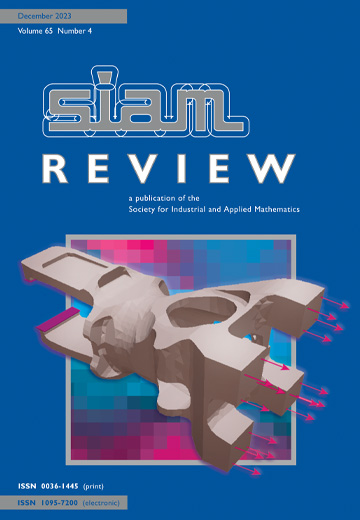当数据驱动的降阶建模遇到全波形反演时
IF 6.1
1区 数学
Q1 MATHEMATICS, APPLIED
引用次数: 0
摘要
SIAM Review》,第 66 卷第 3 期,第 501-532 页,2024 年 5 月。 波形反演是利用发射探测信号的信号源和记录所产生波形的接收器,对以波形方程可变系数建模的异质介质进行估计。这是一个古老而深入研究的反演问题,应用广泛,但现有的反演方法还远远不能令人满意。典型的数学公式是非线性最小二乘数据拟合优化,其困难源于目标函数的非凸性,它显示出许多局部极小值,局部优化方法在这些极小值处停滞不前。这种病态行为至少有三个不可避免的原因:(1)从未知系数到波场的映射是非线性和复杂的。(2) 信号源和接收器通常位于介质的单侧,因此只能测量背向散射波。(3) 探测信号具有频带限制和高频含量。计算科学和工程界有很多活动,试图通过数据拟合来减轻估计介质的难度。在本文中,我们基于控制波传播的两个算子的降阶模型(ROM),提出了一个不同的观点。ROMs 之所以被称为数据驱动模型,是因为它们是直接从测量结果中计算出来的,不需要了解不可接近介质内部的波场。这种计算是非迭代的,使用的是标准的数值线性代数方法。由此产生的 ROM 以一种互补的方式捕捉到了波传播物理学的特征,并具有令人惊讶的良好近似特性,有助于波形反演。本文章由计算机程序翻译,如有差异,请以英文原文为准。
When Data Driven Reduced Order Modeling Meets Full Waveform Inversion
SIAM Review, Volume 66, Issue 3, Page 501-532, May 2024.
Waveform inversion is concerned with estimating a heterogeneous medium, modeled by variable coefficients of wave equations, using sources that emit probing signals and receivers that record the generated waves. It is an old and intensively studied inverse problem with a wide range of applications, but the existing inversion methodologies are still far from satisfactory. The typical mathematical formulation is a nonlinear least squares data fit optimization and the difficulty stems from the nonconvexity of the objective function that displays numerous local minima at which local optimization approaches stagnate. This pathological behavior has at least three unavoidable causes: (1) The mapping from the unknown coefficients to the wave field is nonlinear and complicated. (2) The sources and receivers typically lie on a single side of the medium, so only backscattered waves are measured. (3) The probing signals are band limited and with high frequency content. There is a lot of activity in the computational science and engineering communities that seeks to mitigate the difficulty of estimating the medium by data fitting. In this paper we present a different point of view, based on reduced order models (ROMs) of two operators that control the wave propagation. The ROMs are called data driven because they are computed directly from the measurements, without any knowledge of the wave field inside the inaccessible medium. This computation is noniterative and uses standard numerical linear algebra methods. The resulting ROMs capture features of the physics of wave propagation in a complementary way and have surprisingly good approximation properties that facilitate waveform inversion.
Waveform inversion is concerned with estimating a heterogeneous medium, modeled by variable coefficients of wave equations, using sources that emit probing signals and receivers that record the generated waves. It is an old and intensively studied inverse problem with a wide range of applications, but the existing inversion methodologies are still far from satisfactory. The typical mathematical formulation is a nonlinear least squares data fit optimization and the difficulty stems from the nonconvexity of the objective function that displays numerous local minima at which local optimization approaches stagnate. This pathological behavior has at least three unavoidable causes: (1) The mapping from the unknown coefficients to the wave field is nonlinear and complicated. (2) The sources and receivers typically lie on a single side of the medium, so only backscattered waves are measured. (3) The probing signals are band limited and with high frequency content. There is a lot of activity in the computational science and engineering communities that seeks to mitigate the difficulty of estimating the medium by data fitting. In this paper we present a different point of view, based on reduced order models (ROMs) of two operators that control the wave propagation. The ROMs are called data driven because they are computed directly from the measurements, without any knowledge of the wave field inside the inaccessible medium. This computation is noniterative and uses standard numerical linear algebra methods. The resulting ROMs capture features of the physics of wave propagation in a complementary way and have surprisingly good approximation properties that facilitate waveform inversion.
求助全文
通过发布文献求助,成功后即可免费获取论文全文。
去求助
来源期刊

SIAM Review
数学-应用数学
CiteScore
16.90
自引率
0.00%
发文量
50
期刊介绍:
Survey and Review feature papers that provide an integrative and current viewpoint on important topics in applied or computational mathematics and scientific computing. These papers aim to offer a comprehensive perspective on the subject matter.
Research Spotlights publish concise research papers in applied and computational mathematics that are of interest to a wide range of readers in SIAM Review. The papers in this section present innovative ideas that are clearly explained and motivated. They stand out from regular publications in specific SIAM journals due to their accessibility and potential for widespread and long-lasting influence.
 求助内容:
求助内容: 应助结果提醒方式:
应助结果提醒方式:


